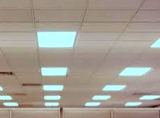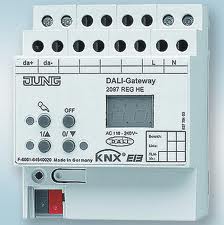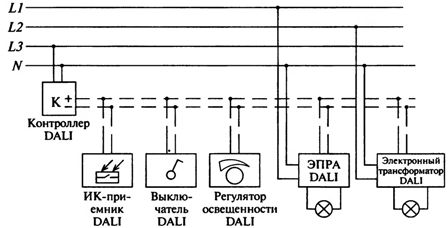Digital lighting control
 The digital lighting control system, in addition to the light source itself, includes:
The digital lighting control system, in addition to the light source itself, includes:
- digital control bus controller (KSh);
- digital control bus (DCB);
- command bodies (COs);
- executive authorities (IO).
There are also various gateways, adapter modules for connecting the control system with other dispatching systems or information systems, as well as for interacting with devices that were not originally designed to work as part of a digital lighting control system.
Digital bus controller — electronic block with memory, means of data exchange with the operator-programmer, modules for processing signals from CO, modules for generating commands for IO. It is usually installed in a lighting or lighting control panel, but there are KSh for open mounting.
The digital control bus is a physical medium designed for the exchange of digital signals between KSh and KO, KSh and EUT, usually a cable with copper conductors of small cross-sections. Both power cables and control and signal cables are used. In special cases, a twisted pair cable is also used.
There are several options for organizing the network topology, in this case ring and bus are used. At using the DALI protocol (Digital Addressable Lighting Interface) — Bus only.
Command bodies — devices used to generate a command to change the mode of operation of the operating system to be controlled. The operator's action can be a stimulus to generate a command (pressing a toggle button or IR remote control, turning a knob, selecting a menu item on touchpad) or a change in the conditions in the surrounding space (change in illumination, the appearance of a moving object in the field of view, etc.). Command authorities usually have an address (personal or group address).
Executive bodies are devices that, at the command of the KSH, transmit the control action directly to the OU to change the mode of its operation. For lighting fixtures with gas discharge lamps and LED modules IO is combined with electronic ballasts.
For GLN low voltage luminaires, the IO is combined with an electronic transformer powering the lamp. For luminaires with incandescent lamps or GLN for mains voltage, the IO is a voltage regulator made in the form of a pencil next to the luminaire or installed in a panel. An executive, like a KO, has a bus address assigned individually or to a group.
When using a digital building management system lighting control system usually built on the basis of the DALI protocol, which is adopted by leading manufacturers of lighting equipment, such as Philips, OSRAM, Helvar, Tridonic. Atco, Zumtobel Staff as an industry standard.

Each ballast and each KO has its own address. Only one DALI controller can handle up to 64 devices in a maximum of 16 individually controllable groups. The DALI controllers are then integrated into the common building management bus (such as E1B, LonWorks, C-Bus, etc.) through the appropriate gateways. For small objects, separate operation of the DALI controller is also possible, which, in addition to direct lighting control, can also be assigned control of shutter and gate drives, as well as the simplest security systems.
The DALI control signal is transmitted over two wires at a voltage of 15 V (this can be any copper pair, be it a twisted pair or an additionally laid power cable). The maximum length of the control line should not exceed 300 m, polarity is not required.
DALI-controlled ballasts can report errors to the controller, such as a burnt-out lamp or thermal protection of the ballast itself. The DALI controller can store up to 16 light scenes that can be called up on demand.
One of the advantages of DALI is that all KOs and EUTs can be galvanically isolated, there is no need to run the same phase to the switches as to the luminaires, and the wiring of the power groups to the luminaires does not have to coincide with the logically defined control groups ( light scenes).
A schematic diagram of lighting control using a digital system is shown in Fig. 1.
Rice. 1. Digital lighting control
The role of the KO is: presence / motion sensors, buttons and remote switches and level controls, timers, light sensors, touch panels, IR receivers controlled by the remote control, as well as computers that control the engineering systems of the building. Sensor panels can either be specially designed for the DALI protocol or be connected to it via gateways.
Light scenes can be called up using any KO, be it touch panels or even conventional switches traditionally used for uncontrolled lighting.
The role of IO is: electronic ballasts of gas discharge lamps, electronic transformers 220/12 V for incandescent halogen lamps, pencil and panel dimmers for incandescent and halogen lamps 220 V, LED lamp ballasts, operating doors, blinds, micro-contactor controllers, relays modules. There are also adapter modules that allow the DALI controller to control analog ballasts from 0-10V.
Advantages and disadvantages of digital lighting control.

Advantages:
— simplicity of the organization — the organization of the control groups in no way affects the organization of the power supply of the lighting fixtures.The number of lighting fixtures per phase is limited only by the PUE requirements for the maximum number of lamps of the corresponding power;
— design flexibility — if necessary, you can change the control logic of the luminaire, the number and composition of groups, just by changing the KSh program. No need to move cables. Connecting KSh through a gateway to a computer or other smart device allows you to have an almost unlimited number of light scenarios and the frequency of their change;
- expandability — the ability to control very small groups of lighting fixtures, up to one piece per group, without significantly complicating the structure;
- ease of installation — connecting new devices is not accompanied by additional operations, except for installing the devices themselves, connecting to the bus and changing the KSH program;
- unification — all QoS and IO are connected according to a single principle, compatible with components of other manufacturers for the same protocol;
- safety — there is no need to supply the mains voltage to the switches, the bus voltage is sufficient, which is always less than the permissible 50 V;
- ease of use — the EUT can inform the controller of the faults that have occurred, and the controller can generate a warning signal to the dispatcher.
Disadvantages:
- high cost of components — digital devices are still more expensive than analog devices. Suppliers often increase the price "for the prestige", the "modernity" of the system. Indirectly, this also leads to an increase in the risk of theft of components installed in areas of uncontrolled access;
- high core cost.Even a simple digital system requires an initial set of devices to function. Control of even one lamp will require KSH, IO and KO;
- the need for highly qualified personnel. Designing, repairing and setting up digital systems requires special technical knowledge and high qualifications. The staff who own them demand a higher salary than the designers and commissioners of analogue systems.
Ancharova T.V. Lighting networks of industrial buildings.

